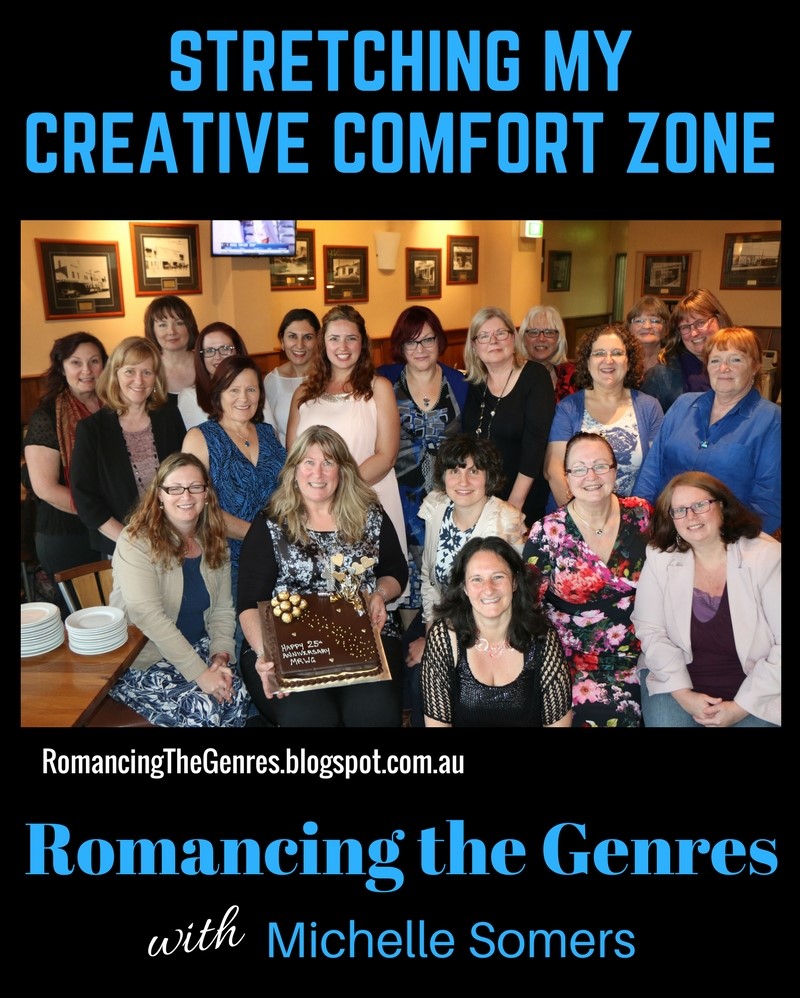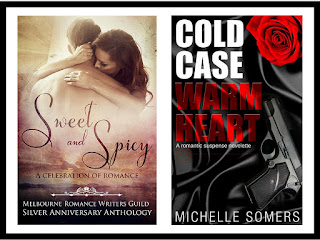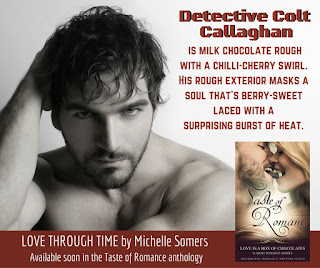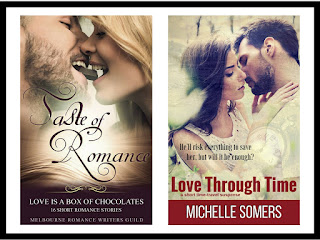A year ago my writing group, the Melbourne Romance Writers Guild (MRWG), decided to put together an anthology titled Sweet and Spicy to mark our 25th anniversary.
The idea excited me. The reality filled me with wave-crashing panic.
At the time, my only published works, Lethal in Love, was in excess of 100,000 words. In the past I’d tried to write ‘short’ and failed miserably. Yet I so wanted to be a part of this event. One that marked a milestone for a group that has given me so much knowledge and love and support throughout my journey to authordom.
So I sat down and began to write.
I aimed for 3,000 words and ended up with something just shy of 9,000. Not as short as I’d planned, more novelette length than short story, but luckily it was just short enough to be included in the anthology. The Sweet and Spicy anthology was released on 10th November 2015, and my short story, Cold Case, Warm Heart, formed a part of it.
On Valentine’s Day this year, MRWG released our second anthology, Taste of Romance, and my story, Love Through Time, clocked in at 4794 words. A vast improvement on last year’s.
Perhaps next year I’ll make that 3,000 word cut-off.
Why do I find writing ‘short’ so challenging? Logic dictates that finding less words should be easier, not harder. Yet, that’s not the case for me. And I doubt I’m alone.
I thought that since Romancing the Genres is all about anthologies this month, I’d take a closer look at the topic, and in particular, what the process of ‘writing short’ taught me about writing in general.
- KISS
A saying as old as the hills and twice as difficult to scale – especially for a die-hard pantser like me! – but the trusty ‘Keep It Simple Stupid’ is really critical here. You don’t have a lot of words to play around with, so make each one count. Dive into your story late, come out early. Yes, wrap everything up with a nice, tidy bow, but leave all the additional frills and sparkles behind.
And no waffle. There’s no time for elaborate prose or a multitude of subplots, a variety of locations, and an army of supporting characters. There aren’t enough words for your story to span more than a limited period of time.
So…
One plot, one conflict and as few characters as possible. Don’t go overboard, otherwise 140,000 words later you’ll have a saga, not a short story.
- Back to Basics
Think about the basic outline of a short story while applying the KISS theory. There are six distinct parts that you need to make sure you include:
Introduction – where you introduce your story’s setting, theme, characters and any other bits of information relevant to the plot, like time, weather, mood, etc.
Initiating action – the event in your story that instigates the rising action.
Rising action – events that bring your story to the climax or turning point.
Climax – the major turning point of your story.
Falling action – events that allow your story to move towards its conclusion.
Resolution and conclusion – a satisfying ending where the central conflict is resolved and any questions raised during the body of your story are answered.
Follow this basic plan and it’ll be near impossible to go wrong.
- Heart and Soul
There are many ways of describing the heart of your story. Some refer to it as the X-factor. A special quality. Something that will set your story apart from others. If you can find that unique something that will capture the attention and imagination of readers and publishers alike, you’ll have one hell of a story.
- Point of Difference
Experiment with different points of view until you find one that is fresh and unique. You want a character who is central to your story – don’t make the mistake of choosing one who’s not – but one who is compelling, who perhaps views the world in a slightly different light to most. This will make for interesting and enthralling reading.
- It’s The Little Things
A strong title will lead readers to your story. A catchy first line or hook will draw them in. And a gripping first few paragraphs will keep them reading. Continue building the tension, keep the plot solid and moving, then conclude with a bang. If those last few words stay with your reader long after they’ve turned the final page, they’ll be hanging out for your next wonderful story. And hopefully you’ll have won a fan for life.
- The Stars
Who are the stars of your story? The leading characters that will capture the hearts of your readers. Make them shine. Make them sing. Make them do what they have to do, then give them the ending you have planned. Do this without fluff and feathers. You don’t have a lot of scope for character development, so make it brief and simple. Sure, you need a character arc, but – you know the term – KISS.
I could keep going, but craft for a short story is not much different to craft for longer works, whether it be a novella or novel.
Just write, enjoy, and remember to have fun. If your story is a slog to write, it’ll be a slog to read. So love every minute of it, and remember, whatever doesn’t work in the draft can be fixed in the editing, so keep going until you are done.
You can’t edit an empty page. So fill it up with words then carve it back down.
And while you’re at it, why not go completely crazy? Step outside your comfort zone and try something different. Writing something short is a great opportunity to write something new, something exciting, something daring.
My story in this year’s anthology is just that. Not only is it a time travel, something I’ve never written before, but it also contains elements of psychological thriller. More romantic elements than an actual romance, Love Through Time is very different to my usual romantic suspense stories.
Not only did I surprise myself by writing outside my genre, but I surprised myself by enjoying the experience more than I’d imagined.
Perhaps if you try it, you may surprise yourself too …
I’d like to leave you with an excerpt of Love Through Time, the first story in our Taste of Romance: Love is a Box of Chocolates anthology:
With shaky fingers, Dee rubbed the opal. Hoped to God it and her mother’s words were more than the folklore she’d once thought. So much depended on it.
What she wanted couldn’t factor right now. Nothing mattered but saving her sister. And if that meant believing in the impossible…
Sudden heat radiated from the stone onto her skin.
A shock of clouds had long-since swallowed the sun. It made no sense. Then again, her life made little sense since a madman had made it his mission to hunt her. To hurt those close to her. Lucy.
She stared at the man before her – the man who would betray her and everything she held dear. He was intertwined with this mess, whether she liked it or not. The chain of events was foretold, although the outcome still shrouded in shadows.
Again she caressed the stone. It revealed nothing, but instinct gave a nudge.
With a quick nod, she shifted forward on the bike before she could change her mind.
Colt grabbed the helmet she’d bought when their lives had been so intertwined she’d imagined a future. Then a body as familiar as her own plastered her back and the connection pierced her very soul.
Warm breath fanned her neck. ‘Where are we going?’
She fired up the engine and headed for the street. ‘To the place it all began.’
Writers and readers, do you venture out of your comfort zone?
Writers, do you have both short and long works in your repertoire? What differences have you found when writing varying length stories? Or even reading them? What similarities? Are there any other tips you’d like to add to my six above? Have you stepped outside your comfort zone lately and challenged your mind? Your writing style? Your imagination?
Readers, do you stick to your go-to genres or do you read anything and everything? I recently read way way outside my comfort zone: The Captive Prince trilogy by C.S.Pacat. And why? Because I heard the author speak at our Romance Writers of Australia’s 2016 conference and her words so enthralled that I wondered if her story would do the same. Boy oh boy was I glad I picked up that first book! What a riveting, thought-provoking read! Imagine if I’d never given it a go?
Have you ever done the same? Been recommended a book that wasn’t your usual genre or story length? Did you give it a go? What was the result? Were you vindicated in your long-standing stance not to venture outside your comfort zone? Or were you pleasantly surprised?
Share your experiences with us now. And perhaps we can all experience a new story, a new author or a new genre. How awesome if we find a new go-to read just by sharing, stepping out of our comfort zone and daring to be different.
 Michelle Somers is a bookworm from way back. An ex-Kiwi who now calls Australia home, she’s a professional killer and matchmaker, a storyteller and a romantic. Words are her power and her passion. Her heroes and heroines always get their happy ever after, but she’ll put them through one hell of a journey to get there.
Michelle Somers is a bookworm from way back. An ex-Kiwi who now calls Australia home, she’s a professional killer and matchmaker, a storyteller and a romantic. Words are her power and her passion. Her heroes and heroines always get their happy ever after, but she’ll put them through one hell of a journey to get there.
Michelle lives in Melbourne, Australia, with her real life hero and three little heroes in the making. And her writing companion, a black furry feline named Emerald. Her debut novel, Lethal in Love won the Romance Writers of Australia’s 2016 Romantic Book of the Year (RuBY) and the 2013 Valerie Parv Award.
The Melbourne Romance Writers Guild Taste of Romance anthology is on sale now! There’s no better time to sink your teeth into a variety of stories by a variety of authors, much like a box of chocolates – you never know what treat you’ll get next.





